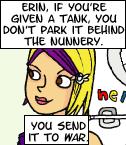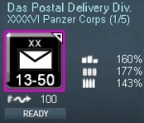BletchleyGeek
Posts: 4713
Joined: 11/26/2009
From: Living in the fair city of Melbourne, Australia
Status: offline

|
quote:
ORIGINAL: pwieland
This asymmetry can be leveraged by a player to ensure unbalanced effects while playing. Personally I dont understand a system in which a Soviet formation is allowed to create ad hoc formations while restricting this capability from the Axis. It does not jibe with the actual flexibility of these two opponents.
Historically, the Soviets experimented with quite a few types of units as they were undergoing a very bloody and costly learning process. They got right the basic idea of deep operations, but coming up with the *right* formations for the job took some time. WiTE allows Soviet players to try out their own solution to the problem of defeating the Wehrmacht.
Now, going to the Axis, I don't think there was at all any kind of "experimenting" with formation and doctrines at the operational level. On the contrary, I would dare to say that the Wehrmacht didn't really "embrace change" as its Soviet and American counterparts did. There's that thing with late war Panzer Brigades - a concept which is very similar to present day Brigade Combat Teams - but my opinion is that they were more a child of necessity than an actual shift in doctrine. I might be wrong, of course.
quote:
ORIGINAL: pwieland
quote:
The issue with mortars you bring up is unclear to me. There are indeed observations on mortars being incredibly effective in the defense, not on the attack. As far as I know, you cannot attach Mortar Bn's to combat units (they qualify as artillery units).
So exploiting this seems to me a bit hard, since arty SU commitment is chance-based (and capped to a max of 6 SU's by eligible HQ). The thing is that rifle corps feature a massive amount of mortars in its TOE, it's just the TOEs of three regular Rifle or Guards Rifle divisions added up together. Therefore, "exploiting" this mortars thing would mean to invest massively on Rifle Corps (which seem to be what every Soviet players do sooner or later). The question is whether WiTE allows Soviet players building too many Rifle Corps (or too many Mortar Bn's, or too many Tank Bn's, or too many Sappers) too soon rather than questioning the feature itself.
If you knew that mortars were effective, would you build any howitzer, gun, or arty formations? Why would you? Players will always attempt to minmax a system (maximize effect at minimum cost- six or more mtr SU's surely would fit that, correct?)
Because mortars work well - too well, yet unconfirmed until we see some change on patch notes - on the defense and against soft targets. Very much like AT guns. So prioritizing them over other platforms would be an optimal strategy while in the defense. To defeat fortifications, hard ground elements and the like you need other types of SU's (tube/rocket arty, sappers, tanks, AT, etc.).
quote:
ORIGINAL: pwieland
quote:
There asymmetry in strategic & logistics options indeed, but the thing is, as Mynok very clearly states, that until the issues that have come up during this year in the tactical combat simulation, fortification and national morale aren't ironed out, it's unclear whether more freedom at the higher level aspects of the game would make any difference whatsoever.
That may be true. How much combat power is gained or lost for changes in morale? I will need to look at the manual a bit to see if there is a description that documents this.
It's hard to quantify pwieland. Nonetheless, the one aspect where high morale (and experience) is key is in limiting losses due to retreat. One of the major problems with the Axis. This, in turn, leads us to the 1:1 -> 2:1 rule thing, which makes retreat to be a more likely outcome. No wonder devs & testers are so prudent: both things are intertwined in a feedback loop.
< Message edited by Bletchley_Geek -- 8/23/2011 7:47:53 PM >
_____________________________
|
 Printable Version
Printable Version


















 New Messages
New Messages No New Messages
No New Messages Hot Topic w/ New Messages
Hot Topic w/ New Messages Hot Topic w/o New Messages
Hot Topic w/o New Messages Locked w/ New Messages
Locked w/ New Messages Locked w/o New Messages
Locked w/o New Messages Post New Thread
Post New Thread